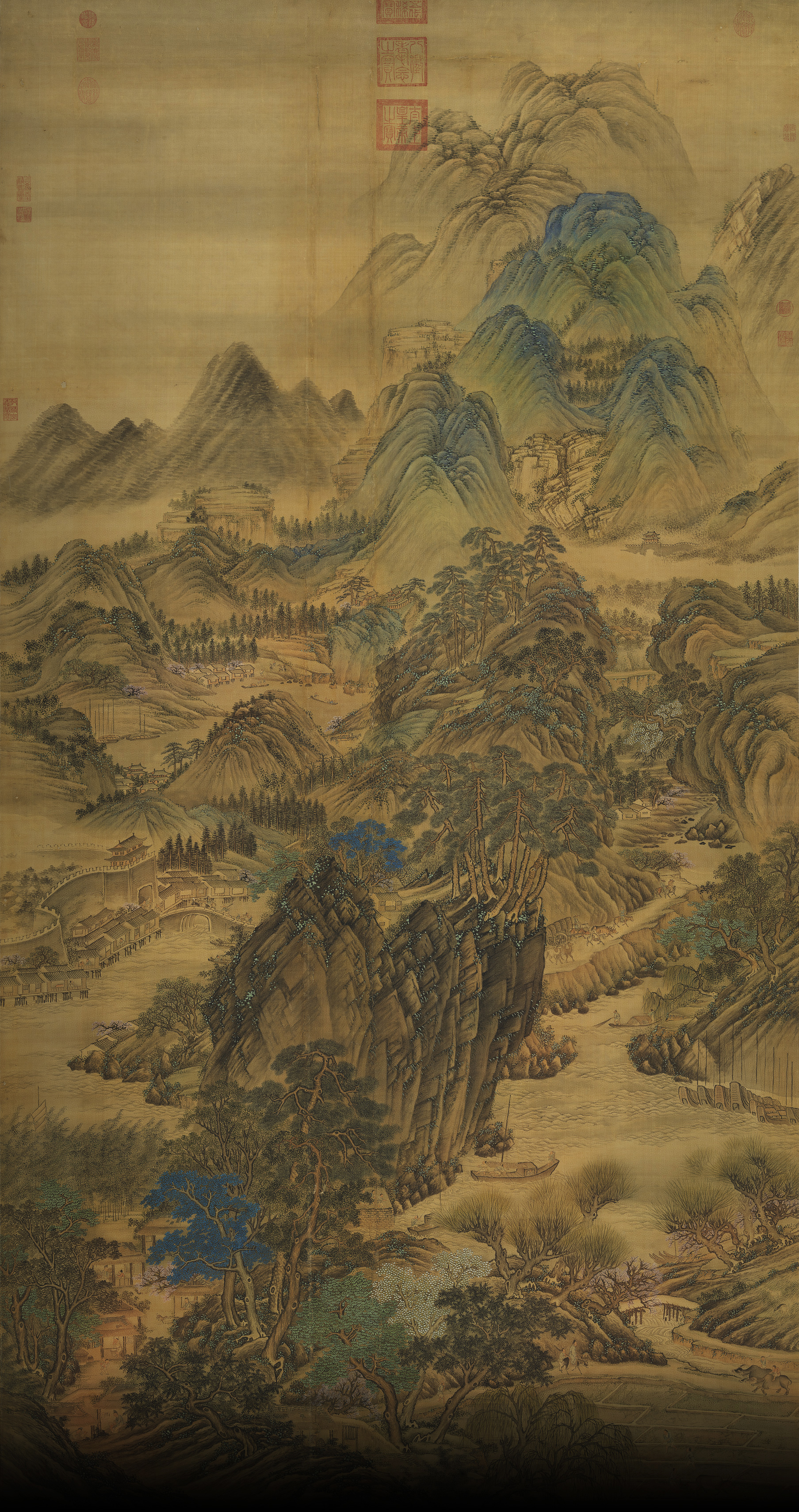Spring Mist over Mountains and Rivers
- Gao Qipei (1672-1734), Qing dynasty
- Hanging scroll, ink and colors on silk, 241.8 x 128.1 cm
Gao Qipei (style name Weizhi; sobriquets Qieyuan, Nancun), a native of Tieling in Liaoning, depicted landscapes both bold and full as well as figures, flowers, and animals all with a form of succinct dynamism. He also developed a technique of finger painting to create an unusually untrammeled effect that was greatly admired at the time.
This painting depicts layers of mountains with luxuriant and verdant vegetation. The foothills of the distant mountains are enveloped in the mists of spring with temples and pavilions scattered here and there. Boats make their way on the river as farmers till the fields nearby, giving the impression of a flourishing atmosphere in springtime. The scenery is well arranged and the brushwork elegant yet strong and focused, the use of ink and colors ranging from light to dark to form a hoary clarity that fully testifies to the artist's skill at rendering the landscape.
Spring Clearing After Rain in the Wu Mountains
- Wen Boren (1502-1575), Ming dynasty
- Hanging scroll, ink on paper, 232.3 x 42.7 cm
Wen Boren (style name Decheng, sobriquet Wufeng) was a native of Suzhou and the nephew of Wen Zhengming (1470-1559). Making a living with his painting, Wen Boren's landscape style can be divided into two types, one abbreviated and the other complex. The former follows the tradition of Wen Zhengming, the brush and ink fine and elegant with scenery that is open and spacious. The latter traces back to the Yuan dynasty artist Wang Meng (1308-1385) with layered mountains featuring texture dots dense and thick.
The pictorial arrangement of this painting is complex and squeezed into a narrow hanging scroll. The artist's mature use of brush and ink texturing creates "hemp-fiber" lines that are piled to form overlapping peaks and crags. Cascades plummet from above as a figure makes his way along a mountain path. The structure of the scenery throughout includes both powerful force and elegant details, making this a masterpiece by Wen Boren from the age of 42.
Brocade of Blossoms on a Spring Day
- Attributed to Shen Zhou (1427-1509), Ming dynasty
- Hanging scroll, ink and colors on paper, 278.6 x 95.7 cm
Shen Zhou (style name Qi'nan; sobriquets Shitian, Baishiweng), a native of Suzhou, was gifted at poetry and prose as well as calligraphy. In painting, he specialized in a variety of subjects, including landscapes and figures, flowers and fruits, and animals of all sorts as he developed a style of sketching ideas. In literati art circles of the Yuan and Ming dynasties, Shen Zhou successfully inherited from the past and paved the way for the future, thus becoming known as the head of the Four Great Masters of the Ming Dynasty.
Two figures are on horseback returning among mountain trees on a spring day as an attendant behind carries items on a shoulder pole. The brushwork throughout the scroll is strong and bold, the area for the folds of the mountains decorated with dark "moss dots" that express an idea of moist and luxuriant vegetation in spring. Although this work carries a Shen Zhou signature, the method of brushwork is slightly stiff and weak, suggesting the hand of a later artist instead.
Late Scenery Along a Riverbank
- Attributed to Dong Yuan (fl. ca. early 10th c.), Five Dynasties period
- Hanging scroll, ink and colors on silk, 179 x 116.5 cm
Dong Yuan, a native of Zhongling (modern Nanjing), was a painter of the Southern Tang dynasty who did landscapes of plain and straightforward scenery in the Jiangnan area. He later became venerated as one of the patriarchs of literati painting.
This scroll, bearing neither seal nor signature of the artist, was identified by the modern master Chang Dai-chien (1899-1983) as a work of Dong Yuan. History records Dong as having a "(painting) type in monochrome ink following Wang Wei and one with colors like Li Sixun." Dong used "hemp-fiber" texture strokes to express the veins of the landscape, to which he added earthen ochre as a color base with layers of mineral blue and green to create a spring-like scene of overflowing abundance. This work follows in the heritage of Dong Yuan and thus had been attributed to him, but modern scholarship points out that, stylistically speaking, it is actually datable to approximately the Yuan dynasty (1279-1368).
Chang Dai-chien bequeathed this painting to the National Palace Museum.

